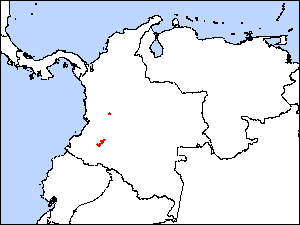
Tolima Dove
Leptotila conoveri
|
Justification This species is known from a very
small number of locations and habitat fragmentation, loss and degradation
are continuing within its very small range. The population is almost
certainly very small, fragmented and declining. It is therefore classified
as Endangered. |
|
|
|
Threats Parts of the upper |
|
Conservation It has not been recorded from any
protected areas. However, an integrated conservation programme for the
forests around the type-locality will hopefully benefit this and other
threatened species in the area. Action for the Yellow-eared Parrot Ognorhynchus
icterotis has increased public awareness and community involvement in
conservation issues in the rToche area, Tolima2, which
should also benefit L. conoveri. |
|
Targets *Evaluate forest cover in its range
and follow-up with surveys of larger blocks to determine the current
population and distribution1. *Investigate the
ecological requirements of this species, especially the degree to which it
tolerates modified habitats. *Protect a stronghold area, if found1.
|
Use Your Browser's Back Button to return to the Previous Page